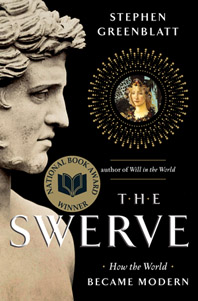Sunday, February 5, 2012
The Swerve: A History of Passionate Reading
I just finished reading Stephen Greenblatt's The Swerve: How the World Became Modern, something that I accomplished in a day. I rarely find myself so enthralled with a nonfiction book that I can't stop reading it, but this instance was even more remarkable since the The Swerve is itself about avid reading. On one level, it narrates the story of a former papal secretary, Poggio Bracciolini, whose passion for ancient texts led him to a German monastery in 1417 and to the discovery of a long-lost poem, On the Nature of Things, by the Roman philosopher Lucretius. The carefully-copied lines asserted Epicurean ideas with such eloquence and daring that--despite its challenge to fundamental precepts of Christianity--Bracciolini sought to make it known again to the world.
At another level, it is about Greenblatt's own fascination with Lucretius. Greenblatt's preface to The Swerve is an eloquent testament to the power of a text to strike, thrill, and infiltrate one's daily life. As he explained: "It was not Lucretius' exquisite language to which I was responding. Later I worked through De rerum natura in its original Latin hexameters, and I came to understand something of its rich verbal texture, its subtle rhythms, and the cunning precision and poignancy of its imagery, but my first encounter was in Martin Ferguson Smith's workmanlike English prose...No, it was something else that reached me, something that lived and moved within the sentences for more than 200 densely packed pages"(2).
Some have cited Greenblatt's engaging analysis of Epicureanism and its influence on Enlightenment thinking, but, for me, what is most significant are Greenblatt's insights into the history of ardent audiences. Most importantly, Greenblatt argues that for Bracciolini to be so passionate about books in the early 1400s was strange: "To all but a handful of people in Germany, this quest, had Poggio tried to articulate it, would have seemed weird"(18). Books were valued mostly in monasteries in the 15th century; all monks had to know how to read and were expected to engage in both "prayerful reading" and manual labor as part of their vocation. This institutionalization of reading was good for the survival of ancient texts; in order to read, the monks had to have books, and they learned to carefully reproduce texts through copying. However, it was not necessarily a joyful or exciting affair--reading and copying were, for most, compulsory chores.
Even more significant than Bracciolini's strange avidity for books was the fact that he was not alone. Greenblatt cites a small but earnest community of humanists in Italy that were devoted to uncovering and collecting lost classics. "Italians had been obsessed with book-hunting for the better part of a century, ever since the poet and scholar Petrarch brought glory on himself around 1330 by piecing together Livy's monumental History of Rome and finding forgotten masterpieces by Cicero, Propertius, and others." (23) Petrarch, Greenblatt suggests, set the model for Bracciolini, by investing "this search with a new, almost erotic urgency and pleasure, superior to all other treasure seeking" (119). Greenblatt quotes Petrarch's own assessment: "Gold, silver, jewels, purple garments, houses built of marble, groomed estates, pious paintings, caparisoned steeds, and other things of this kind offer a mutable and superficial pleasure; books give delight to the very marrow of one's bones. They speak to us, consult with us, and join with us in a living and intense intimacy."
As the story unfolds, it becomes clear that this love of books among humanists in 15th century Italy was actually an emulation of the intellectual culture of the ancient world, in which, "it became increasingly fashionable for wealthy Romans to amass large private libraries in their town houses and country villas...whether on the banks of the Rhone in Gaul or near the grove and Temple of Daphne in the province of Syria, on the island of Cos, near Rhodes, or in Dyrrhkhion in what is now Albania, the houses of cultivated men and women had rooms set aside for quiet reading." Even more remarkable, Greenblatt states that in the first century CE, the first reader-fans emerge: "At the games in the Colosseum one day, the historian Tacitus had a conversation on literature with a perfect stranger who turned out to have read his works. Culture was no longer located in close-knit circles of friends and acquaintances; Tacitus was encountering his 'public' in the form of someone who had bought his book at a stall in the Forum or read it in a library" (60-63). Based on Robert Darnton's work on Jean-Jaques Rousseau's public readership (See "Readers Respond to Rousseau" in The Great Cat Massacre), I had always associated this sort of public reader-author relationship with changing social and urban contexts of the 18th century, but this is a tantalizing revision.
There are other great tidbits in The Swerve about book hunting and collecting, about the circulation of ideas in Renaissance society, and about those whose lives were deeply shaped by the recovery and maintenance of a lost, seemingly better, past. In the end, The Swerve is really about a fan-like love of learning, from Lucretious in the first century BCE, to Bracciolini in in the early 15th century, to Greenblatt today. Their enthusiastic encounters with texts, together with one's own potentially enthusiastic reading, have the power to accumulate--or resonate together--to form an extended community of reception.
Subscribe to:
Post Comments (Atom)

No comments:
Post a Comment